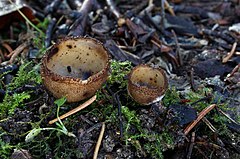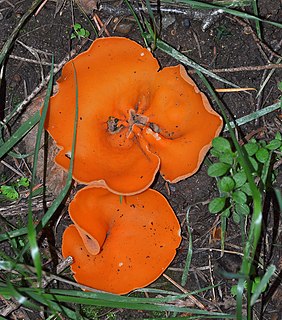
Aleuria aurantia is a widespread ascomycete fungus in the order Pezizales. The brilliant orange, cup-shaped ascocarps often resemble orange peels strewn on the ground, giving this species its common name.

Karl Wilhelm Gottlieb Leopold Fuckel was a German botanist who worked largely on fungi.

Exobasidium is a genus of fungi in the family Exobasidiaceae. The genus has a widespread distribution, especially in northern temperate regions, and contains about 50 species. Many of the species in this genus are plant pathogens that grow on Ericaceae.
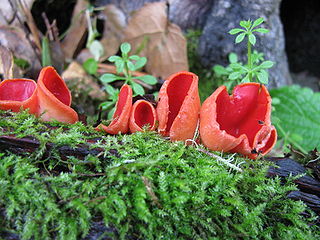
Sarcoscypha coccinea, commonly known as the scarlet elf cup, scarlet elf cap, or the scarlet cup, is a species of fungus in the family Sarcoscyphaceae of the order Pezizales. The fungus, widely distributed in the Northern Hemisphere, has been found in Africa, Asia, Europe, North and South America, and Australia. The type species of the genus Sarcoscypha, S. coccinea has been known by many names since its first appearance in the scientific literature in 1772. Phylogenetic analysis shows the species to be most closely related to other Sarcoscypha species that contain numerous small oil droplets in their spores, such as the North Atlantic island species S. macaronesica. Due to similar physical appearances and sometimes overlapping distributions, S. coccinea has often been confused with S. occidentalis, S. austriaca, and S. dudleyi.
The Didymosphaeriaceae are a family of fungi in the order Pleosporales. The family was erected by Anders Munk in 1953.

The Sarcoscyphaceae are a family of cup fungi in the order Pezizales. Members of the Sarcoscyphaceae are cosmopolitan in distribution, found in both tropical and temperate regions.

Humaria hemisphaerica, commonly known as the hairy fairy cup or the brown-haired fairy cup, is a species of fungi in the family Pyronemataceae. This mycorrhizal fungus is recognized by its white inner surface and hairy brown outer surface. The specific epithet is derived from the Latin word hemisphaericum, meaning half a sphere.
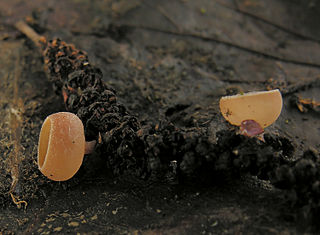
Ciboria is a genus of fungi in the family Sclerotiniaceae. The widespread genus, which currently contains about 21 species, was circumscribed by the German botanist Karl Fuckel in 1870.
Plagiostoma is a genus of fungi in the family Gnomoniaceae. The genus contains 22 species.
Linospora is a genus of fungi in the family Gnomoniaceae. The genus contains four species.
Gnomoniella is a genus of fungi in the family Gnomoniaceae. The genus contains 13 species. Gnomoniopsis is a genus of fungi in the family Gnomoniaceae including:
Gibberidea is a genus of fungi in the class Dothideomycetes. The relationship of this taxon to other taxa within the class is unknown. The genus was named by German mycologist Karl Wilhelm Gottlieb Leopold Fuckel in 1870.

Rhopographus is a genus of fungi in the class Dothideomycetes. The relationship of this taxon to other taxa within the class is unknown.

Helvella acetabulum is a species of fungus in the family Helvellaceae, order Pezizales. This relatively large cup-shaped fungus is characterized by a tan fruit body with prominent branching ribs resembling a cabbage leaf; for this reason it is commonly known as the cabbage leaf Helvella. Other colloquial names include the vinegar cup and the brown ribbed elfin cup. The fruit bodies reaches dimensions of 8 cm (3.1 in) by 4 cm (1.6 in) tall. It is found in Asia, Europe, and North America, where it grows in sandy soils, under both coniferous and deciduous trees.

Plectania is a genus of fungi in the family Sarcosomataceae. There are 15 species in the genus, which have a widespread distribution, especially in northern temperate areas. Plectania was circumscribed by German botanist Karl Wilhelm Gottlieb Leopold Fuckel in 1870.

Pseudoplectania is a genus of fungi in the family Sarcosomataceae. The genus contains 12 species. Pseudoplectania ryvardenii was described in 2012, while Pseudoplectania carranzae was transferred to the genus in 2013.
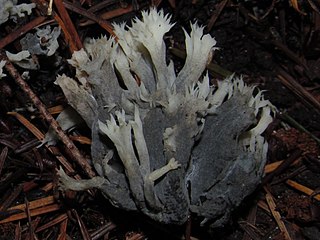
Helminthosphaeria is a genus of fungi in the family Helminthosphaeriaceae (Ascomycota).

Pseudoplectania nigrella, commonly known as the ebony cup, the black false plectania, or the hairy black cup, is a species of fungi in the family Sarcosomataceae. The fruit bodies of this saprobic fungus are small blackish cups, typically up to 2 cm (0.8 in) broad, that grow in groups on soil, often amongst pine needles and short grass near coniferous trees. Pseudoplectania nigrella has a worldwide distribution, and has been found in North America, the Caribbean, Britain, Europe, India, Madagascar, New Zealand, and Japan. The fungus produces a unique chemical compound, plectasin, that has attracted research interest for its ability to inhibit the growth of the common human pathogenic bacterium Streptococcus pneumoniae.

Otidea is a genus of fungi in the family Pyronemataceae. The genus is widely distributed in northern temperate regions.
Trachyspora is a genus of rust fungi in the family Phragmidiaceae. The genus, widespread in northern temperate areas, contains six species.
